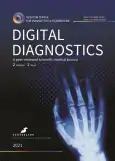Diagnosis of solitary eosinophilic granuloma by CT, MRI, and 18F-FDG PET/CT: two clinical cases
- Авторлар: Gelezhe P.B.1,2, Bulanov D.V.2,3
-
Мекемелер:
- Moscow Center for Diagnostics and Telemedicine
- Joint-Stock Company “European Medical Center”
- The Russian National Research Medical University named after N.I. Pirogov
- Шығарылым: Том 2, № 1 (2021)
- Беттер: 75-82
- Бөлім: Case reports
- URL: https://journals.rcsi.science/DD/article/view/59690
- DOI: https://doi.org/10.17816/DD59690
- ID: 59690
Дәйексөз келтіру
Аннотация
This paper presents two clinical cases of eosinophilic granuloma of bone diagnosed by CT, MRI, and 18F-FDG PET/CT. In both cases the patients were admitted to the clinic with suspected primary malignant bone tumor and the diagnosis of a solitary eosinophilic granuloma was made based on the results of comprehensive radiological diagnostic examination and histological verification. Solitary eosinophilic granuloma of bone is an infrequent condition, occurring in less than 1% of cases of skeletal tumor masses. The most common eosinophilic granuloma is found in the parietal and frontal bones of the skull and is an osteolytic volumetric mass that gradually increases in size. Although most bone tumors can be detected by radiography, computed tomography is preferred, primarily because of its superior ability to detect cortical bone destruction. The diagnostic accuracy of computed tomography and magnetic resonance imaging may be different. The combined use of radiological and radionuclide methods allows us to narrow the spectrum of differential diagnosis. Unfortunately, relatively low specificity of existing radiological diagnostic studies in most cases does not allow to establish a precise diagnosis, and biopsy with subsequent pathological examination remains the method of choice. These clinical observations demonstrate the need to include eosinophilic granuloma in the differential diagnosis when a solitary osteolytic focus is detected.
Толық мәтін
##article.viewOnOriginalSite##Авторлар туралы
Pavel Gelezhe
Moscow Center for Diagnostics and Telemedicine; Joint-Stock Company “European Medical Center”
Хат алмасуға жауапты Автор.
Email: gelezhe.pavel@gmail.com
ORCID iD: 0000-0003-1072-2202
SPIN-код: 4841-3234
MD
Ресей, 28-1, Srednyaya Kalitnikovskaya street, Moscow, 109029; MoscowDmitriy Bulanov
Joint-Stock Company “European Medical Center”; The Russian National Research Medical University named after N.I. Pirogov
Email: dbulanov@emcmos.ru
ORCID iD: 0000-0001-7968-6778
SPIN-код: 4641-1505
MD, Cand. Sci. (Med.)
Ресей, Moscow; MoscowӘдебиет тізімі
- Lam KY. Langerhans cell histiocytosis (histiocytosis X). Postgrad Med J. 1997;73(861):391–394. doi: 10.1136/pgmj.73.861.391
- Herzog KM, Tubbs RR. Langerhans cell histiocytosis. Adv Anat Pathol. 1998;5(6):347–358. doi: 10.1097/00125480-199811000-00001
- Arseni C, Dănăilă L, Constantinescu A. Cranial eosinophilic granuloma. Neurochirurgia (Stuttg). 1977;20(6):189–199. doi: 10.1055/s-0028-1090377
- Ardekian L, Peled M, Rosen D, et al. Clinical and radiographic features of eosinophilic granuloma in the jaws: Review of 41 lesions treated by surgery and low-dose radiotherapy. Oral Surg Oral Med Oral Pathol Oral Radiol Endod. 1999;87(2):238–242. doi: 10.1016/s1079-2104(99)70279-9
- Willatt JM, Quaghebeur G. Calvarial masses of infants and children. A radiological approach. Clin Radiol. 2004;59(6):474–486. doi: 10.1016/j.crad.2003.12.006
- Ginat DT, Mangla R, Yeaney G, et al. Diffusion-Weighted imaging for differentiating benign from malignant skull lesions and correlation with cell density. Am J Roentgenol. 2012;198(6):W597–W601. doi: 10.2214/AJR.11.7424
- Davies AM, Pikoulas C, Griffith J. MRI of eosinophilic granuloma. Eur J Radiol. 1994;18(3):205–209. doi: 10.1016/0720-048x(94)90335-2
- Dimitrakopoulou-Strauss A, Strauss LG, Heichel T, et al. The role of quantitative 18F-FDG PET studies for the differentiation of malignant and benign bone lesions. J Nucl Med. 2002;43(4):510–518.
- Culverwell AD, Scarsbrook AF, Chowdhury FU. False-positive uptake on 2-[18F]-fluoro-2-deoxy-D-glucose (FDG) positron-emission tomography/computed tomography (PET/ CT) in oncological imaging. Clin Radiol. 2011;66(4):366–382. doi: 10.1016/j.crad.2010.12.004
- Schulte M, Brecht-Krauss D, Heymer B, et al. Grading of tumors and tumorlike lesions of bone: evaluation by FDG PET. J Nucl Med. 2000;41(10):1695–1701.
- Martinez-Lage JF, Poza M, Cartagena J, et al. Solitary eosinophilic granuloma of the pediatric skull and spine ― the role of surgery. Childs Nerv Syst. 1991;7(8):448–451. doi: 10.1007/BF00263187
- Oliveira M, Steinbok P, Wu J, et al. Spontaneous resolution of calvarial eosinophilic granuloma in children. Pediatr Neurosurg. 2003;38(5):247–252. doi: 10.1159/000069828
- Rawlings CE, Wilkins RH. Solitary eosinophilic granuloma of the skull. Neurosurgery. 1984;15(2):155–161. doi: 10.1227/00006123-198408000-00001
Қосымша файлдар









